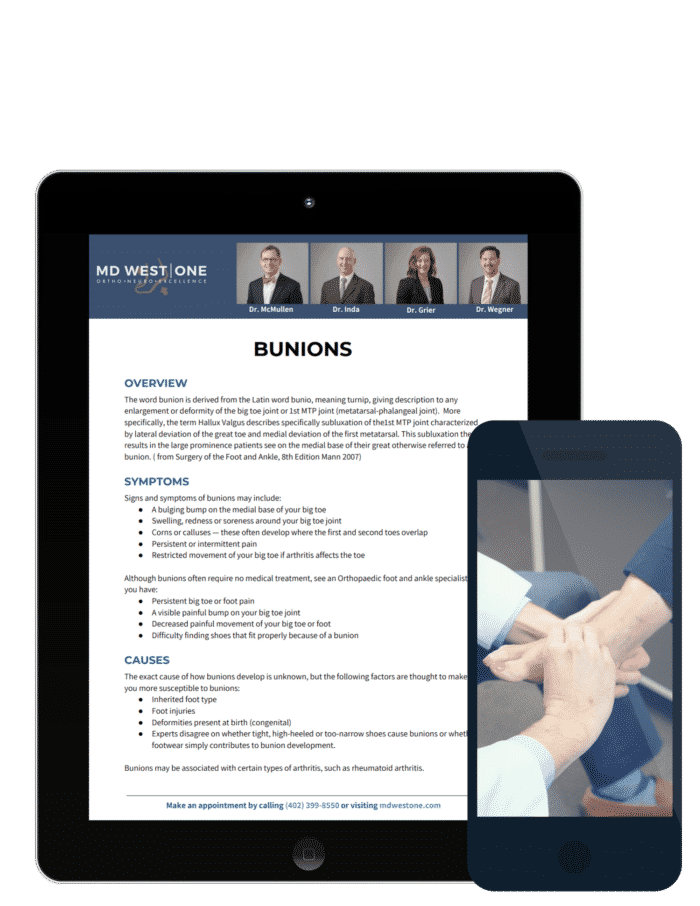Are you suffering from toe and foot pain due to Bunions?
The Omaha Foot & Ankle Specialists at MD West ONE are able to properly diagnose and treat bunions through both surgical and non-surgical treatments. If you have the following symptoms, you may want to make an appointment with one of our Board Certified Specialists.
- A bulging bump on the medial base of your big toe
- Swelling, redness or soreness around your big toe joint
- Corns or calluses — these often develop where the first and second toes overlap
- Persistent or intermittent pain
- Restricted movement of your big toe if arthritis affects the toe
Meet MD West ONE's foot and ankle specialists and learn more about how they treat bunions.
Bunions Causes, Treatments & Surgery
What is a Bunion?
The word bunion is derived from the Latin word bunio, meaning turnip, giving the description to any enlargement or deformity of the big toe joint or 1st MTP joint (metatarsal-phalangeal joint). More specifically, the term Hallux Valgus describes specifically subluxation of the1st MTP joint characterized by lateral deviation of the great toe and medial deviation of the first metatarsal. This subluxation then results in the large prominence patients see on the medial base of their great otherwise referred to as a bunion. ( from Surgery of the Foot and Ankle, 8th Edition Mann 2007)
What is the Cause of Bunions?
The exact cause of how bunions develop is unknown, but the following factors are thought to make you more susceptible to bunions:
- Inherited foot type
- Foot injuries
- Deformities present at birth (congenital)
- Experts disagree on whether tight, high-heeled or too-narrow shoes cause bunions or whether footwear simply contributes to bunion development.
Bunions may be associated with certain types of arthritis, such as rheumatoid arthritis.
The following factors may increase your risk of bunions:
-
High heels - Wearing high heels forces your toes into the front of your shoes, often crowding your toes.
-
Ill-fitting shoes - People who wear shoes that are too tight, too narrow or too pointed are more susceptible to bunions.
-
Rheumatoid arthritis - Having this inflammatory condition can make you more susceptible to bunions.
-
Heredity - The tendency to develop bunions might be because of an inherited structural foot defect.
Bunion Complications
Bunions are permanent unless surgically corrected. Possible complications include:
- Bursitis - This painful condition occurs when the small fluid-filled pads (bursae) that cushion bones, tendons and muscles near your joints become inflamed.
- Hammertoe - An abnormal bend that occurs in the middle joint of a toe, usually the toe next to your big toe, can cause pain and pressure.
- Metatarsalgia - This condition causes pain and inflammation in the ball of your foot.
EVALUATION
An MD West ONE Specialist can identify a bunion by examining your foot. After the physical exam, an X-ray of your foot can help us identify the cause of the bunion and rate its severity.
Treatment options vary depending on the severity of your bunion and the amount of pain it causes.
NON-SURGICAL TREATMENT OPTIONS
Nonsurgical treatments that may relieve the pain and pressure of a bunion include:
- Padding and taping or splinting - Use over-the-counter, nonmedicated bunion pads. Also, your doctor can help you tape your foot in a normal position. This can reduce stress on the bunion and alleviate your pain.
- Medications - Acetaminophen (Tylenol, others), ibuprofen (Advil, Motrin IB, others) or naproxen sodium (Aleve) can help you control the pain of a bunion. Cortisone injections also might help.
- Shoe changes - Padded shoe inserts can help distribute pressure evenly when you move your feet, reducing your symptoms and preventing your bunion pain from getting worse. Over-the-counter arch supports or prescription orthotic devices can provide relief for some people. Shoe accommodations such as wider toe box shoes, foam or gel toe spacers and soft bunion splints may provide symptomatic relief of bunion pain.
- Applying ice - Icing your bunion after you've been on your feet too long or if it becomes inflamed can help relieve soreness and inflammation.
BUNION SURGICAL TREATMENT OPTIONS
If non-surgical treatments don’t alleviate bunion pain, then surgical treatments may be recommended. The MD West ONE Foot & Ankle Specialists pride themselves on approaching foot and ankle care conservatively and will only recommend surgery if absolutely necessary. Surgical procedures for bunions might involve:
- Removing the swollen tissue from around your big toe joint
- Straightening your big toe by removing part of the bone
- Realigning the long bone (metatarsal) of your foot and possibly realigning your big toe bone, by way of cutting the bone, realigning and securing the bone cut with hardware to straighten out the abnormal angle in your big toe joint
- Joining or fusing the bones of your big toe joint permanently while also realigning the toe
The length of non-weight bearing after bunion surgery depends on the specific surgical management of your bunion. This ranges from immediate weight bearing as tolerated to up to 6 weeks non-weight bearing or longer. This determination can be made after a clinical visit and x-ray evaluation of your specific deformity. However, full recovery can take months.
Recurrence of your bunion is always a risk even after surgical correction. To prevent recurrence, you'll need to wear proper shoes after recovery. For most people, it's unrealistic to expect to wear narrower shoes after surgery.
BUNION POST-OPERATIVE RECOVERY
Maximal improvement may take several months and in some cases up to a year. Pain experienced after bunion surgery is variable. Typically, your surgeon can use regional anesthesia to help with some of the immediate post-operative pain. Suggestions for decreasing pain and inflammation include; elevation of the involved limb, frequent ice application for 10-15 minute intervals, and medication (Tylenol, Advil or narcotic pain medicine prescribed at the time of surgery). Typically narcotic pain medications are only needed for a couple of days after surgery.
Elevation is the most important post-operative instruction after bunion surgery. Although the actual weight-bearing instructions can vary depending on the specific bunion procedure, the recommendation for elevation is standard. The more the foot is elevated, the better.
Non-weight bearing postoperatively can be aided by the use of crutches or a roller-aide/knee scooter.
BUNION POST-OPERATIVE INSTRUCTIONS
Dressings placed by your surgeon are wrapped in a specific manner post-operatively to protect the soft tissue balancing performed during the bunion surgery and should not be changed or removed by anyone other than your surgeon or their associates. Dressings will be changed at the time of your first post-operative visit.
Patients are typically placed in a hard sole surgical shoe or boot post-operatively and sometimes a short leg splint is applied. Specific management is surgeon dependent and sometimes dictated by the specific surgery required.
Can you drive after bunion surgery?
- If the operative leg is the LEFT leg, you are allowed to drive if you are no longer taking narcotic pain medications and feel comfortable.
- When the operative leg is the RIGHT leg, driving is NOT allowed for up to 4-6 weeks, sometimes longer, depending on your surgical healing.
Your first post-operative visit will be scheduled approximately 7-14 days after surgery. Your stitches will be removed at that time if appropriate and the surgical wound assessed.
Edema (swelling) control, scar massage, and desensitization techniques are initiated when the incision heals.
Specific wraps or splints may be applied to your foot at your first post-operative appointment.
Instructions on range-of-motion exercises for your great toe joint will be provided at your first post-operative visit as well. Perform each exercise 10 times, 3-5 times a day.
BUNION POST-OPERATIVE EXPECTATIONS
Bunion surgery is typically regarded as a difficult surgery and recovery for patients. Because it involves the foot and often times a period of non-weight bearing, it can be difficult.
The dependency of the foot and gravity can make swelling in the foot persist for months. Compression stockings can often be utilized post-operatively to help with swelling.
Work restrictions vary depending on the work demands and time off of work can vary from a couple days to a couple months or longer.
BUNION SURGICAL RISKS/COMPLICATIONS
Risks with regard to bunion surgery include but are not limited to infection, blood clots, anesthetic risk, and stiffness of the great toe joint, nerve irritation, recurrence of the bunion deformity, hallux varus deformity (where the great toe drifts medially), hardware complications, and non-union.
Don't wait any longer to get relief. Make an appointment to see one of our orthopedic specialists.
AMERICAN ORTHOPAEDIC FOOT & ANKLE SOCIETY
All of the foot and ankle surgeons in the practice are recognized members of the American Orthopaedic Foot & Ankle Society. It is the oldest and most prestigious medical society dedicated to the foot and ankle. The mission of the society is to advance science and practice of foot and ankle surgery through education, research, and advocacy on behalf of patients and practitioners. These physicians dedicate their time and energy to improving the patient experience and their knowledge in their field. For more information visit http://www.aofas.org.
MD West ONE Foot & Ankle Specialists:
The Foot & Ankle Specialists are all Board Certified and Fellowship-Trained, meaning they’ve focused their education, training and research on orthopedic surgery of the foot and ankle.






